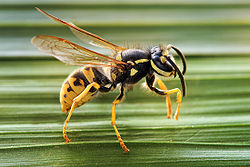| Revision as of 04:42, 1 December 2012 editBeno1000 (talk | contribs)Pending changes reviewers3,659 editsmNo edit summary← Previous edit | Revision as of 17:55, 12 March 2013 edit undoYerpo (talk | contribs)Extended confirmed users, Pending changes reviewers, Rollbackers11,875 editsm →References: --confused interwikis (served at d:Q7037230)Next edit → | ||
| Line 53: | Line 53: | ||
| ] | ] | ||
| ] | |||
| ] | |||
| ] | |||
| ] | |||
| ] | |||
| ] | |||
| ] | |||
| ] | |||
| ] | |||
| ] | |||
| ] | |||
| ] | |||
| ] | |||
| ] | |||
| ] | |||
| ] | |||
| ] | |||
| ] | |||
| ] | |||
| ] | |||
| ] | |||
| ] | |||
| ] | |||
| ] | |||
| ] | |||
Revision as of 17:55, 12 March 2013
| Vespidae | |
|---|---|

| |
| Vespula germanica | |
| Scientific classification | |
| Kingdom: | Animalia |
| Phylum: | Arthropoda |
| Class: | Insecta |
| Order: | Hymenoptera |
| Suborder: | Apocrita |
| Superfamily: | Vespoidea |
| Family: | Vespidae |
| Subfamilies | |
|
Eumeninae: potter wasps | |
The Vespidae are a large (nearly 5,000 species), diverse, cosmopolitan family of wasps, including nearly all the known eusocial wasps and many solitary wasps. Each social wasp colony includes a queen and a number of female workers with varying degrees of sterility relative to the queen. In temperate social species, colonies usually only last one year, dying at the onset of winter. New queens and males (drones) are produced towards the end of the summer, and after mating, the queens hibernate over winter in cracks or other sheltered locations. The nests of most species are constructed out of mud, but polistines and vespines use plant fibers, chewed to form a sort of paper (also true of some stenogastrines). Many species are pollen vectors contributing to the pollination of several plants, being potential or even effective pollinators, while others are notable predators of pest insect species.
The subfamilies Polistinae and Vespinae are composed solely of eusocial species, while Eumeninae, Euparagiinae, and Masarinae are all solitary; the Stenogastrinae subfamily contains a variety of forms from solitary to social.
In Polistinae and Vespinae, rather than consuming prey directly, prey are masticated and fed to the larvae, and the larvae, in return, produce a clear liquid (with high amino acid content) which the adults consume; the exact amino acid composition varies considerably among species, but it is considered to contribute substantially to adult nutrition.
Gallery
-
 German wasp
German wasp
-
 A median wasp nest
A median wasp nest
-
Polistes nest
-
Another angle
-
 Vespa tropica from India
Vespa tropica from India
-
 Dolichovespula media (a European tree wasp) stripping wood from a fence for use in nest construction
Dolichovespula media (a European tree wasp) stripping wood from a fence for use in nest construction
External links
- Evolutionary history of social behavior in Vespids
- Vespidae of the world - iconographic work
- Stunning photographs of Vespidae (and other insects) in flight
- Vespidae: Potter wasps; vespid wasps; social wasps; hornets; paper wasps; yellowjackets
References
- Sühs, R.B.; Somavilla, A.; Putzke, J.; Köhler, A. 2009. Pollen vector wasps (Hymenoptera, Vespidae) of Schinus terebinthifolius Raddi (Anacardiaceae), Santa Cruz do Sul, RS, Brazil. Brazilian Journal of Biosciences 7, n. 2, p. 138-143. Link: http://www.ufrgs.br/seerbio/ojs/index.php/rbb/article/view/1123
- Hunt, J. H., I. Baker, and H. G. Baker. 1982. Similarity of amino acids in nectar and larval saliva: the nutritional basis for trophallaxis in social wasps. Evolution 36: 1318-1322